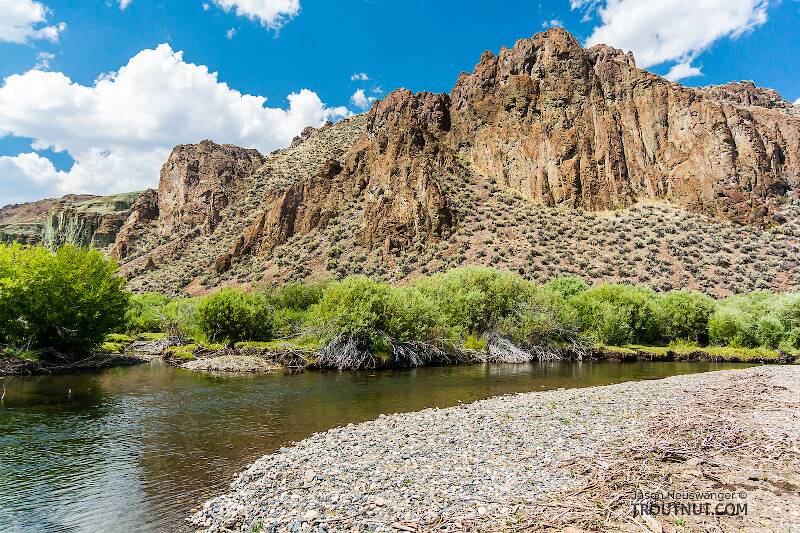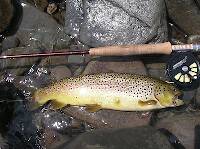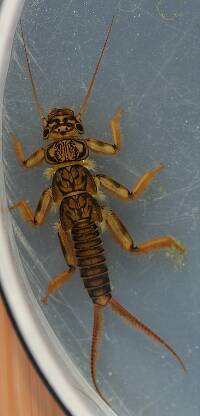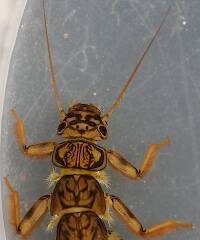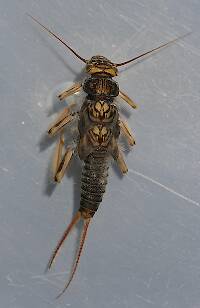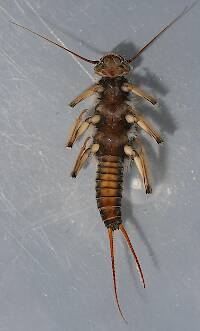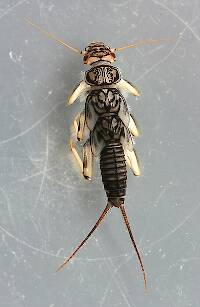
Hex Mayflies
Hexagenia limbata
The famous nocturnal Hex hatch of the Midwest (and a few other lucky locations) stirs to the surface mythically large brown trout that only touch streamers for the rest of the year.
Featured on the forum

I was not fishing, but happened to be at an unrelated social event on a hill above this tiny creek (which I never even saw) when this stonefly flew by me. I assume it came from there. Some key characteristics are tricky to follow, but process of elimination ultimately led me to Sweltsa borealis. It is reassuringly similar to this specimen posted by Bob Newell years ago. It is also so strikingly similar to this nymph from the same river system that I'm comfortable identifying that nymph from this adult. I was especially pleased with the closeup photo of four mites parasitizing this one.

Troutnut is a project started in 2003 by salmonid ecologist Jason "Troutnut" Neuswanger to help anglers and
fly tyers unabashedly embrace the entomological side of the sport. Learn more about Troutnut or
support the project for an enhanced experience here.
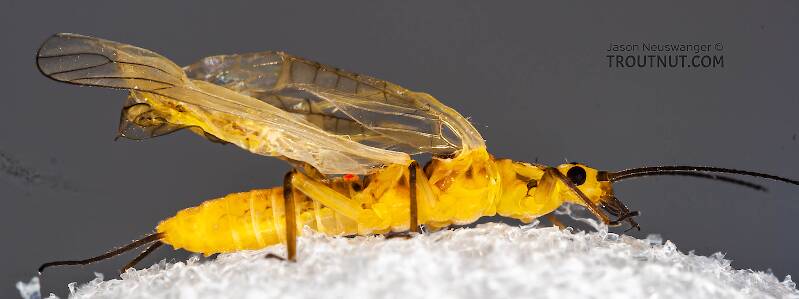
A friend brought me this stonefly to photograph. He found it floating on the surface of a trout stream with its wings in a crippled position.
IanB
Posts: 3
Posts: 3
IanB on May 5, 2009May 5th, 2009, 6:25 am EDT
Ok all, I am finding this hobie increasingly interesting and exciting. I no longer will just be guessing on the river, but actually selecting flies that best represent the actual bugs I am finding.
Here is another one from yesterday's trip, there are many of these flying around as adult, some size 14, others down to size 18, I grabbed one of the larger ones (just pushing size 14) and got some better macro pictures.
Thanks for the help in identifying this 'small' stonefly (that is my identification at this point anyway). Taken May 4th 2009 in the North Shore of Mass.
I apologize, but although I have re-sized these pictures (way down in some cases) I can not get them to display here. Links are posted instead.
IB
https://stillmaninteriors.sslpowered.com/Images/DSCN2185.JPG
other angle
https://stillmaninteriors.sslpowered.com/Images/DSCN2182.JPG
And another angle
https://stillmaninteriors.sslpowered.com/Images/DSCN2185.JPG
Here is another one from yesterday's trip, there are many of these flying around as adult, some size 14, others down to size 18, I grabbed one of the larger ones (just pushing size 14) and got some better macro pictures.
Thanks for the help in identifying this 'small' stonefly (that is my identification at this point anyway). Taken May 4th 2009 in the North Shore of Mass.
I apologize, but although I have re-sized these pictures (way down in some cases) I can not get them to display here. Links are posted instead.
IB
https://stillmaninteriors.sslpowered.com/Images/DSCN2185.JPG
other angle
https://stillmaninteriors.sslpowered.com/Images/DSCN2182.JPG
And another angle
https://stillmaninteriors.sslpowered.com/Images/DSCN2185.JPG
GONZO on May 5, 2009May 5th, 2009, 10:08 am EDT
IanB-
Your stonefly is a member of the Taeniopterygidae, aka "winter stoneflies" or "willowflies." The smaller stoneflies that you saw might belong to another family, the Nemouridae, aka "spring stoneflies" or "forestflies." The emergence of some members of these two families overlaps at this time of year. (They look much alike, but the nemourids are generally smaller, emerge later, and have shorter second tarsal segments.)
BTW, per your previous thread, the #14 mayfly nymphs in the cup with your damselfly nymph are probably Hendrickson nymphs (Ephemerella subvaria).
Your stonefly is a member of the Taeniopterygidae, aka "winter stoneflies" or "willowflies." The smaller stoneflies that you saw might belong to another family, the Nemouridae, aka "spring stoneflies" or "forestflies." The emergence of some members of these two families overlaps at this time of year. (They look much alike, but the nemourids are generally smaller, emerge later, and have shorter second tarsal segments.)
BTW, per your previous thread, the #14 mayfly nymphs in the cup with your damselfly nymph are probably Hendrickson nymphs (Ephemerella subvaria).
Quick Reply
Related Discussions
Topic
Replies
Last Reply
1
Jan 29, 2016
by Martinlf
by Martinlf
1
Mar 9, 2012
by Wiflyfisher
by Wiflyfisher
1
Aug 30, 2010
by GONZO
by GONZO
13
Mar 30, 2021
by Taxon
by Taxon

